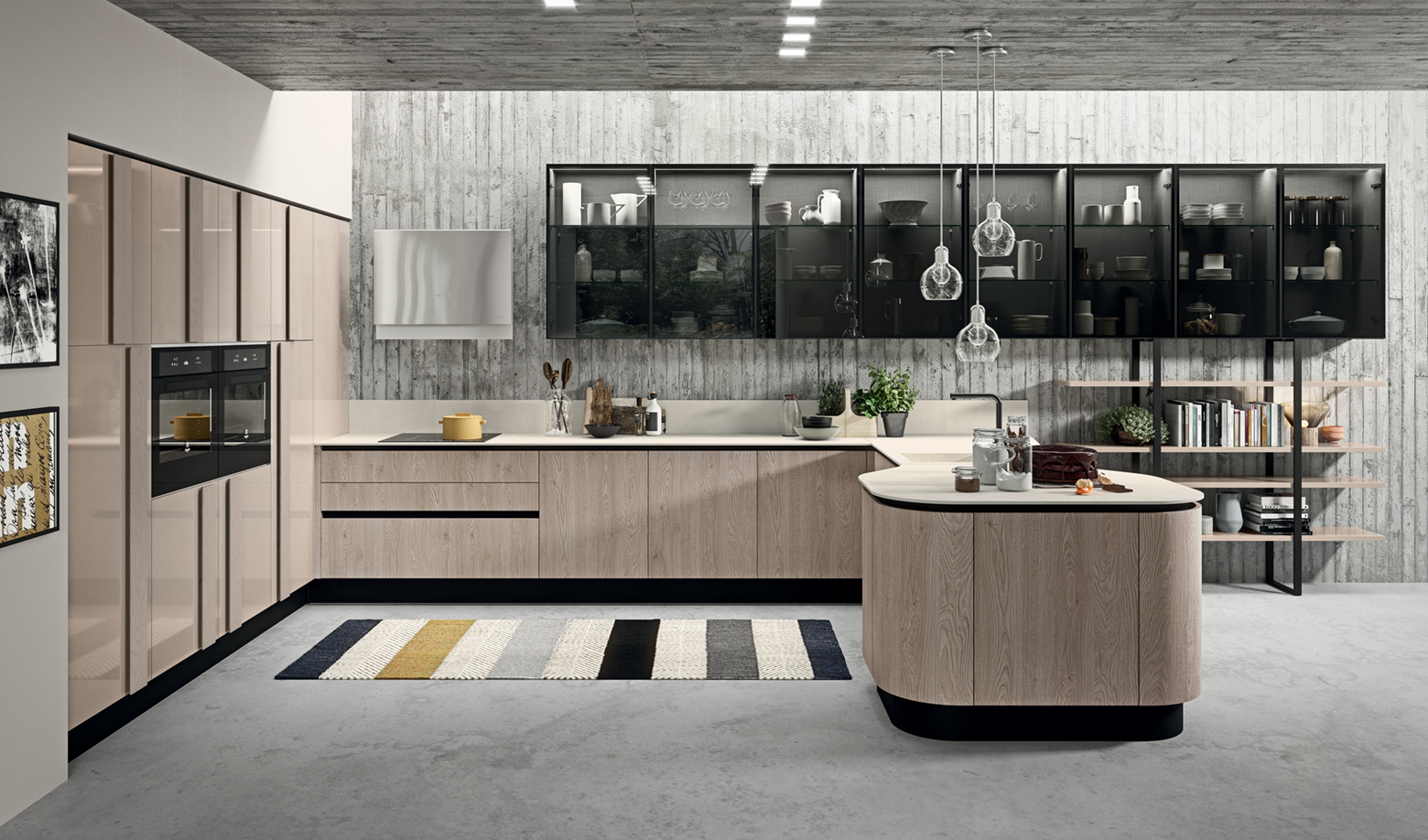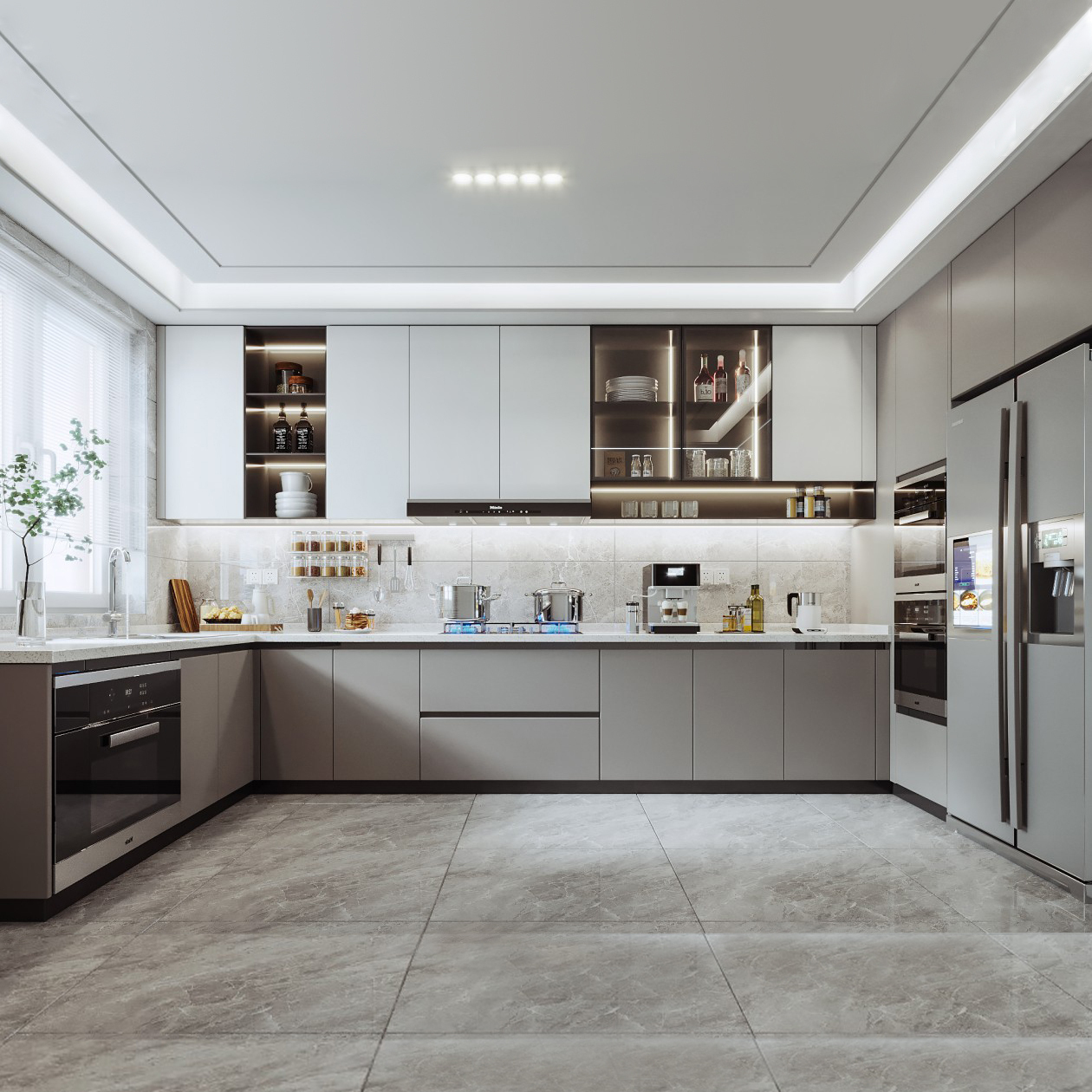Design Trends in Contemporary European Kitchen Cabinets

Contemporary European kitchen cabinets are renowned for their sleek, minimalist aesthetics and functional design. These cabinets embody a modern approach to kitchen design, emphasizing clean lines, simple forms, and a focus on functionality. This style seamlessly blends with contemporary living spaces, creating a harmonious and sophisticated ambiance.
Materials Used in Contemporary European Kitchen Cabinets
Contemporary European kitchen cabinets often feature a combination of materials that contribute to their unique visual appeal and durability.
- Wood: Natural wood, particularly oak, walnut, and cherry, is a popular choice for contemporary European cabinets. It offers a timeless elegance and warmth that complements the minimalist design aesthetic. The wood’s natural grain patterns and variations add a touch of organic beauty to the kitchen space.
- Metal: Metal accents, such as stainless steel or brushed aluminum, are frequently incorporated into contemporary European kitchens. These materials provide a sleek and modern look, often used for cabinet handles, drawer pulls, and even entire cabinet fronts. The reflective surface of metal adds a touch of sophistication and contributes to the overall minimalist aesthetic.
- Stone: Natural stone, such as granite, marble, or quartz, is often used for countertops and backsplashes in contemporary European kitchens. These materials add a touch of luxury and durability, complementing the clean lines and minimalist design of the cabinets. The unique veining and patterns found in natural stone create a visually striking and sophisticated focal point in the kitchen.
Color Palettes and Finishes
Contemporary European kitchen cabinets often feature a palette of neutral colors, accented by bold pops of color or natural textures.
- Neutral Tones: White, gray, and black are popular choices for contemporary European kitchen cabinets, as they create a sense of spaciousness and allow for versatility in styling. These neutral tones serve as a backdrop for colorful accents and natural textures, allowing the overall design to shine.
- Bold Accents: To add a touch of personality and visual interest, bold accent colors are often incorporated into contemporary European kitchens. These colors can be used for cabinet doors, backsplashes, or even appliances. Popular choices include deep blues, emerald greens, and warm terracotta tones.
- Natural Textures: Natural textures, such as wood grain, stone patterns, or woven fabrics, are frequently used to add warmth and depth to contemporary European kitchen cabinets. These textures create visual interest and contrast against the sleek, minimalist design of the cabinets.
Functionality and Ergonomics: Contemporary European Kitchen Cabinets

Contemporary European kitchen cabinets are not just about aesthetics; they prioritize functionality and ergonomics, creating spaces that are both beautiful and practical. This approach emphasizes ease of use, efficient workflow, and maximum storage capacity, transforming the kitchen into a truly user-friendly environment.
Efficient Workflow and Ease of Movement
Efficient workflow is paramount in a contemporary European kitchen. Cabinet placement and design play a crucial role in optimizing movement and minimizing wasted steps. The “work triangle” concept, which positions the sink, stove, and refrigerator in a triangular configuration, is often employed to ensure a smooth and intuitive workflow. This layout encourages a natural flow of movement, reducing unnecessary steps and enhancing efficiency.
- Strategic Placement: Cabinets are strategically positioned to maximize accessibility and minimize movement. For example, frequently used items are placed within easy reach, while less frequently used items are stored in higher cabinets or pull-out drawers.
- Open and Clear Spaces: Contemporary European kitchens often feature open and uncluttered spaces to facilitate movement. This approach emphasizes functionality over visual clutter, creating a sense of spaciousness and ease of movement.
- Ergonomic Design: Cabinets are designed with ergonomics in mind. Features such as adjustable shelves, pull-out drawers, and soft-close mechanisms ensure smooth and effortless operation, reducing strain and fatigue.
Innovative Storage Solutions
Contemporary European kitchens are renowned for their innovative storage solutions, maximizing space and creating a highly organized environment. These solutions are often integrated seamlessly into the cabinet design, maximizing both functionality and aesthetics.
- Integrated Spice Racks: Built-in spice racks, often located near the stovetop, provide easy access to frequently used spices, eliminating the need for bulky spice jars and maximizing counter space.
- Pull-Out Pantries: Pull-out pantries offer a highly efficient way to store a wide variety of items. These pantries are typically fitted with adjustable shelves, allowing for customized storage and easy access to even the smallest items.
- Custom-Designed Organizers: Contemporary European kitchens often feature custom-designed organizers to optimize storage within cabinets and drawers. These organizers can be tailored to specific needs, such as utensil holders, pot and pan organizers, and plate racks.
Sustainability and Environmental Considerations

The growing awareness of environmental issues has significantly influenced contemporary European kitchen design, leading to a strong emphasis on sustainable practices. This shift towards eco-conscious design is not just a trend; it’s a fundamental principle that prioritizes responsible material sourcing, energy-efficient appliances, and eco-friendly finishes.
The Importance of Sustainable Practices
Sustainable practices in contemporary European kitchen design are essential for minimizing the environmental impact of kitchen cabinets and appliances. These practices are not only beneficial for the planet but also contribute to a healthier and more sustainable lifestyle.
Use of Recycled Materials
The use of recycled materials in contemporary European kitchen design is becoming increasingly common. These materials can include recycled wood, metal, and plastic, reducing the demand for virgin resources and lowering the carbon footprint of the kitchen.
- Recycled wood is often used for cabinet frames, doors, and drawer fronts, offering a sustainable alternative to virgin wood. It is sourced from reclaimed wood, salvaged from old buildings, or industrial waste, minimizing deforestation and promoting responsible forest management.
- Recycled metal is used in kitchen appliances, countertops, and hardware. These materials are often made from aluminum, stainless steel, or copper, which can be recycled multiple times without compromising quality.
- Recycled plastic is used in some kitchen components, such as drawer organizers, cabinet liners, and countertop materials. Recycled plastic offers a durable and cost-effective option while reducing plastic waste.
Energy-Efficient Appliances
Energy-efficient appliances are a crucial element of sustainable kitchen design. These appliances are designed to consume less energy while maintaining high performance, reducing energy consumption and minimizing environmental impact.
- Energy-efficient refrigerators use advanced insulation and cooling technologies to minimize energy consumption, saving money on utility bills and reducing greenhouse gas emissions. They are often rated with an Energy Star label, indicating their energy efficiency.
- Energy-efficient dishwashers use water-saving features and advanced cleaning technologies to reduce water and energy consumption. They are often equipped with features like automatic cycles, adjustable spray arms, and sensor-based technology to optimize water and energy usage.
- Energy-efficient ovens use innovative heating elements and insulation to minimize energy consumption while delivering consistent cooking results. They often feature features like convection cooking, self-cleaning cycles, and programmable timers to optimize energy efficiency.
Eco-Friendly Finishes
Eco-friendly finishes are increasingly popular in contemporary European kitchen design. These finishes are made from sustainable materials and are designed to minimize environmental impact.
- Natural stone countertops, such as granite, marble, and quartz, are durable and beautiful, offering a sustainable alternative to synthetic materials. They are quarried responsibly, with minimal environmental impact, and are often sourced locally, reducing transportation costs and emissions.
- Sustainable wood finishes, such as reclaimed wood, bamboo, and certified sustainable hardwoods, are used for cabinet doors, drawer fronts, and other kitchen components. These finishes are harvested responsibly, minimizing deforestation and promoting forest regeneration.
- Low-VOC paints and varnishes are used for cabinet finishes and other surfaces, reducing the release of harmful volatile organic compounds (VOCs) into the air. These paints and varnishes are safer for the environment and contribute to a healthier indoor environment.
Responsible Sourcing and Manufacturing Processes
Responsible sourcing and manufacturing processes are essential for ensuring the environmental impact of kitchen cabinets is minimized. This involves selecting materials from sustainable sources, using energy-efficient manufacturing processes, and reducing waste generation.
- Sustainable wood sourcing involves obtaining wood from certified sustainable forests, ensuring that trees are harvested responsibly and replaced with new growth. This practice helps to protect biodiversity, prevent deforestation, and ensure the long-term health of forests.
- Energy-efficient manufacturing involves using renewable energy sources, reducing energy consumption in production processes, and minimizing waste generation. This can include using solar or wind power, optimizing production lines, and implementing recycling programs.
- Minimizing waste is crucial for sustainable manufacturing. This involves reducing waste generation, reusing materials, and recycling waste products. This can include implementing efficient production processes, using recycled materials, and composting organic waste.
Eco-Friendly Features, Contemporary european kitchen cabinets
Contemporary European kitchens often incorporate eco-friendly features to promote sustainability and reduce environmental impact. These features are designed to conserve water, energy, and resources, contributing to a greener lifestyle.
- Water-saving faucets use aerators or flow restrictors to reduce water consumption without compromising water pressure. This feature conserves water and reduces energy consumption for heating water.
- Energy-efficient lighting uses LED bulbs, which consume less energy than traditional incandescent bulbs, reducing energy consumption and greenhouse gas emissions. LED bulbs also last longer, reducing the need for frequent replacements.
- Sustainable wood certifications, such as the Forest Stewardship Council (FSC) certification, ensure that wood used in kitchen cabinets comes from responsibly managed forests. This certification guarantees that the wood is harvested sustainably, promoting forest health and biodiversity.
Contemporary European kitchen cabinets often prioritize sleek minimalism, emphasizing clean lines and functional design. This aesthetic, however, can sometimes present a challenge when it comes to integrating necessary electrical outlets, a problem cleverly addressed by the kitchen under cabinet outlet strip.
This discreet solution allows for convenient power access without compromising the overall streamlined look of the modern European kitchen.
Contemporary European kitchen cabinets are often lauded for their sleek lines and minimalist aesthetic, a stark contrast to the more ornate styles prevalent in other regions. However, even within this minimalist design ethos, there is room for subtle embellishments and functional accents.
The freeport 2 door accent cabinet , for instance, offers a touch of traditional charm with its intricate detailing and ample storage space, seamlessly blending with the modern sensibilities of a contemporary European kitchen.
